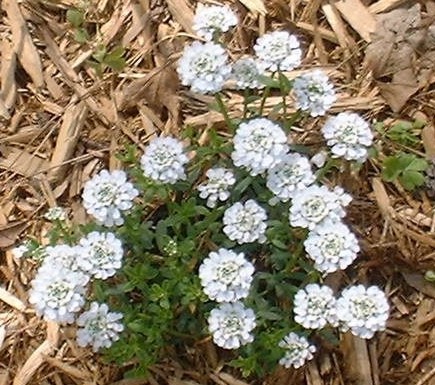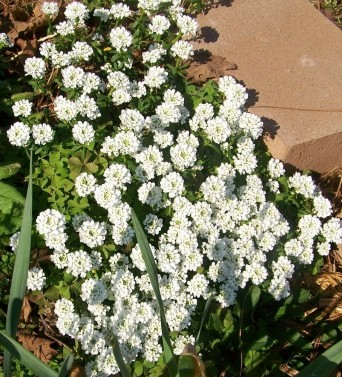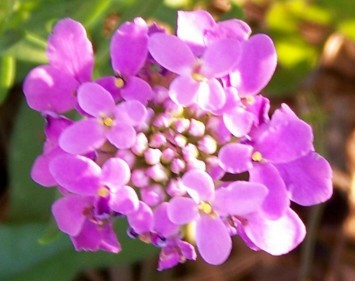|
Gardens Ablaze |
||
|
|
Candytuft |
|
|
Additional Perennial Profiles Site Map
Home
|
Perennial Candytuft (Iberis sempervirens) is actually a hardy evergreen sub-shrub that will reliably survive all the way down to zone 3, and sends up showy blooms very early in the in the spring. Mine beat even the early Daffodils by a week or two this year. Flowers are startlingly bright white on shrubby little plants with needle-like leaves, and when in full bloom, they cover the entire plant.
Perennial Candytuft is easy to start from seeds or cuttings. Seeds will germinate within about two weeks. Cuttings are slow to take root, but as long as the cutting is still green, just be patient and keep it watered and eventually it will start showing new growth. I took some cuttings of the plant above and only one cutting made it, but I think I did this when the weather was still too cool. Had I waited for the temperature to warm a little more, I think I would have had more success. Root division can also be done, but it is difficult not to break off the stems when doing divisions. If you feel you must divide this plant for some reason, be sure to do it in the fall. Perennial Candytuft is not terribly particular about soil conditions, other than it absolutely demands a well-drained situation. The plant above is in a thick bed of mulch that keeps the moisture constant, but does not allow for standing water. Fertilize Candytuft every couple of months with an all-purpose, slow-release flowering plant fertilizer to keep the plants happy and healthy through the hotter weather. Candytuft prefers full sun, but will tolerate some shade. Candytuft seed pods are small and inconspicuous, and don't add anything to the looks of the plant. If you are not planning to collect seed, the plants can be trimmed with scissors after flowering, and they should continue flowering intermittently through the summer. The uses for Perennial Candytuft are almost limitless. It is one of the greats for rock gardens or for spilling over a wall. It makes a wonderful border plant for walkways and paths that when flowering is amazing. When not flowering it is a loose green mat that might get a little scraggly-looking in hot weather, but other plants can be interspersed to keep the color going. The plant grows to 10-12 inches high and is truly a carefree front of the border plant for those too busy to fuss in the garden every weekend. I have a neighbor with Candytuft at the base of her mailbox, and for a couple of months out of the year, that mailbox planting just jumps out at you as you drive by. As a ground cover, this plant is about as good as it gets, or it can be used as a permanent feature in bare spots in the perennial garden wherever needed.
Candytuft was an herb that was often used in Colonial times, mostly for rheumatism, gastrointestinal complaints, bronchial problems, and asthma symptoms. The whole plant is edible, but it is very bitter and for this reason has no uses in the modern kitchen. More recent studies have shown that it does have some merit cases of unexplainable gastric problems, but again, the taste is so bitter that any homemade remedy would taste too bad to be useful. There are, however, herbal preparations in existence with Candytuft as an ingredient that seem to be of some benefit in certain cases.
Custom Search
|
|
|
Gardens Ablaze |
||
 Candytuft
(Iberis) is a marvelous little plant that has a place in virtually
any gardening situation except deep shade. There are both perennial
and annual varieties of Candytuft, and all make charming additions to the
garden.
Candytuft
(Iberis) is a marvelous little plant that has a place in virtually
any gardening situation except deep shade. There are both perennial
and annual varieties of Candytuft, and all make charming additions to the
garden.  Perennial
Candytuft is a relatively fast grower. To illustrate, the plant above
was put into the garden in the summer of 2006, and a picture of it in early
spring, 2007 is to the right. It has at least quadrupled in size,
and was really beautiful in the garden. If this plant likes its situation,
it will amaze you with its easy care and pure white beauty.
Perennial
Candytuft is a relatively fast grower. To illustrate, the plant above
was put into the garden in the summer of 2006, and a picture of it in early
spring, 2007 is to the right. It has at least quadrupled in size,
and was really beautiful in the garden. If this plant likes its situation,
it will amaze you with its easy care and pure white beauty.
 Annual
Candytuft (Iberis Umbellata) is a plant that is just about as wonderful
as its Perennial cousin. It flowers within a couple of months from
seed, and colors range from white to pink to purple. It is a taller
and less compact plant than Perennial Candytuft, but as you can see, the
colors are striking and it makes a wonderful addition to the garden, especially
in mass plantings, and can be used in the same context in the garden as
the Perennial types. Annual Candytuft is often found in wildflower
and annual mixes due to its easy seeding and growth habits.
If you are a beginning gardener, this is the plant for you, as it will make
you look like you really know what you are doing! This is also a good plant
for gardening with kids, because it grows and flowers so fast from seed.
Annual Candytuft may make it through the winter if you are in a more temperate
area if you snip the seed pods after flowering and give it a good bed of
mulch in the fall.
Annual
Candytuft (Iberis Umbellata) is a plant that is just about as wonderful
as its Perennial cousin. It flowers within a couple of months from
seed, and colors range from white to pink to purple. It is a taller
and less compact plant than Perennial Candytuft, but as you can see, the
colors are striking and it makes a wonderful addition to the garden, especially
in mass plantings, and can be used in the same context in the garden as
the Perennial types. Annual Candytuft is often found in wildflower
and annual mixes due to its easy seeding and growth habits.
If you are a beginning gardener, this is the plant for you, as it will make
you look like you really know what you are doing! This is also a good plant
for gardening with kids, because it grows and flowers so fast from seed.
Annual Candytuft may make it through the winter if you are in a more temperate
area if you snip the seed pods after flowering and give it a good bed of
mulch in the fall.